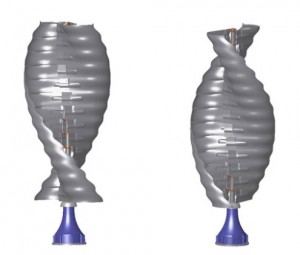Helix Wind was a renewable energy company founded in 2005 that specialized in producing and installing vertical axis wind turbines in the United States. Originally stationed in California, Helix Wind was a company which targeted to deliver high quality, efficient, and cost effective, environment-friendly power solutions to both residential and commercial consumers alike.
Note: Helix Wind has been purchased by Sauer Energy, who continue to sell the Helix Wind technology.
Although it started out fresh and full of promise, the company unfortunately didn’t last long. Helix Wind suffered from major management, service and quality issues; until finally, in May 2010, it had stopped operations and all its assets and intellectual property were sold to Sauer Energy, another green energy company.
Despite being short lived, Helix Wind had shown the potential of becoming a leader in the green energy industry. The products it sold were considered unique for its kind and had the capability of providing efficient energy to their clients.
Each of Helix Wind’s vertical axis wind turbines were designed with helix, sail-like blades, called Savonius-style, that were unique compared to the wind turbines sold by other companies of the same nature. The turbines had scoops or aerofoils, arranged around a vertical shaft that was turned by the wind, making it look like a large corkscrew in motion.
In the market, Helix Wind offered two different models of wind turbines, each of which were designed to accommodate to the specific energy needs of residential and commercial consumers alike.
[youtuber youtube=’http://www.youtube.com/watch?v=9_xrlMV9EKM’]
The first model was the S322 Turbine: a small vertical axis wind turbine primarily designed to cater to the needs of residential houses and small commercial businesses. The S322 was capable of delivering 2.0kW of energy at peak, with a lifespan designed to last up to 30 years and with a warranty of 5 years. Helix Wind markets the S322 is perfect for those who simply wanted to have an environment friendly backup power source or to simply cut energy costs.
The second model was the S594 Turbine, which had twice the size and twice the power of the S322. Perfectly designed for those in need of more energy, the S594 was capable of delivering up to 4.5kW of energy at peak, which made it as an ideal solution for bigger commercial business and institutions.
As an option, consumers who purchased wind turbines from Helix Wind also had the option to purchase the Helix WTMS, also known as the Helix Wind Turbine Monitoring System. As the name implies, the WTMS was a system designed to allow consumers to monitor how much energy they were producing and consuming. It also displayed the temperature, wind speed and other related environment variables—making it as an ideal purchase with the turbines.
The most notable project that Helix Wind got involved in was the empowerment of cell phone towers in US and Africa with vertical axis wind turbines. The project kicked off at October 2010 and was established to target to reduce cell phone tower operating costs and CO2 emissions in the environment. There were no news whatsoever whether the project was completed successfully or not.
To conclude, despite being a has-been company, Helix Wind had briefly showed the potential of becoming a market leader in the green energy industry. The products it sold were raved and talked about by consumers and obviously were at par with the current trend in green energy. A few tweaks in sales, management and quality assurance could have saved the company from the unfortunate situation they had gotten into.

